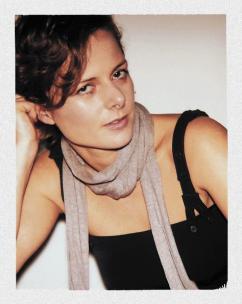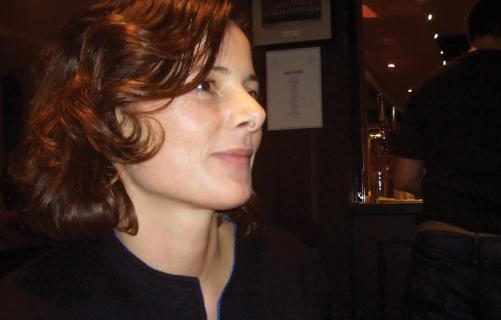Dining Quickly
How many free Fendi bags come with a job at Vogue? Is the office filled with fashionable Stepford wives? Benj Ohad Seidler meets Vogue’s Harriet Quick to find out
When I met Harriet Quick at the Cambridge train station, the Fashion Features Director of British Vogue smiled at me with warm restraint and we got into a cab heading towards St. John’s College, where we were to dine. She was on her phone when the cab dropped us off outside the college chapel, whilst the final notes of evensong were being chanted.
Harriet’s coat highlighted her small frame in the darkness, and every step she took caused the black wool to swing, revealing a strikingly bright azurite inner face that matched the blue of the stained glass windows behind her. Her voice rapping quickly over the choral melody, Harriet continued chatting to someone called George at the other end of the line about a recent acupuncture-related misadventure as she stood in the cold. Once we reached the entrance to John’s hall it turned out my friends, who had the tickets, were going to be late. Bored of cigarettes and clearly freezing, Harriet suggested going to the bar for a drink, and I replied awkwardly by telling her how enthusiastic I was about Theyskens’ upcoming debut for Rochas.
We were still not clicking when the two architecture students that were to dine with us finally joined us in the hall, clad in carefully pre-meditated outfits. “I like your dress,” Harriet commented as she greeted them and we chose our seats at the runway-length table that was adorned with red place settings and white china that bounced the candlelight of the faded gold carvings onto our faces and our bottle of red 
wine. The majestic chocolate wood walls glittered with severe portraits of stern-looking men and women.
 Between delicate bites of suspect food and generous swigs of red, Harriet seemed to be dangling imaginary pearls from her right hand as she raced through her professional life story with assiduously chosen words. Harriet spoke first of her childhood as the daughter of an interior designer mother and an antique-dealing stepfather in a Midlands household where talk of materials and aesthetics frequently wove itself into conversations. That, mixed with what she called a newfound penchant for “design conversation” in the national press motivated her to venture into design journalism. After completing her BA in History of Art and English at York, Harriet was accepted to City University for a journalism MA.
Between delicate bites of suspect food and generous swigs of red, Harriet seemed to be dangling imaginary pearls from her right hand as she raced through her professional life story with assiduously chosen words. Harriet spoke first of her childhood as the daughter of an interior designer mother and an antique-dealing stepfather in a Midlands household where talk of materials and aesthetics frequently wove itself into conversations. That, mixed with what she called a newfound penchant for “design conversation” in the national press motivated her to venture into design journalism. After completing her BA in History of Art and English at York, Harriet was accepted to City University for a journalism MA.
“I entered the Guardian/Jackei Moore Fashion Writing competition and I won that,” Harriet continued decisively, banishing a strand of bronze hair from her dishevelled bob away from her face. In 1992, she also won the Vogue Talent Contest for Young Writers, and is heralded as one of the contests’ foremost success stories. “It started opening doors,” she explained, and surely enough she began writing freelance for The Face and i-D, where all the fashion powerhouses of her generations became her circle of friends.
Vogue offered her three days a week with a “shockingly bad” salary, but when a writing job opened at the fashion desk of The Guardian, Harriet chose the full-time job. The Guardian was striving to bring a more general readership into its fashion pages and Harriet painted the moment by talking about the feature she wrote about a “lesbian with one leg” and how she never really got into the whole “fashion frivolity is evil” mantra of the grunge era. She also launched ideas like the first ‘fashion at Glastonbury’ feature and studies on the lives of male models, which were unusual topics at the time.
As the nineties wound down Harriet swapped the cubicles of The Guardian for the oak desks of the V&A library in order to research her seminal book on the history of the modelling profession, Catwalking. The first-time author only got paid a meagre flat rate for a book that would have earned her a small fortune in royalties. She shrugged, though her half-smile-under-a-pointed-nose-countenance remained immobile. Her blue knitwear undulated down her tiny frame and her long neck warmed her throat so that she had no problem talking solidly over a wonderfully jam-packed hour about how, after a short time working at the Telegraph, she finally got to be editor-in-chief of a magazine, namely the short-lived Frank.
The “fantastic” magazine’s aim was to “cut the bullshit” and Harriet became animated to such an extent that one would venture to say that working at Frank was the highlight of her career, at least until Vogue, due to the fact that it allowed her to experiment so much (she once hired a gymnast to acrobatically change the slides during a presentation to the big bosses). Advertisers, however, were sceptical about joining the fun and when the company was sold, Harriet was left with the “horrendous experience of sacking everyone” before finding a new job herself, this time at Vogue.
The Guardian was striving to bring a more general readership into its fashion pages and Harriet painted the moment by talking about the feature she wrote about a 'lesbian with one leg'
Harriet’s move to Vogue happened seven years ago and she has become one of the magazine’s most identifiable figures due to her distinct and vibrant writing style in major design-based features. She described her style, and the Vogue style, as “entertaining yet sceptical yet informative” and says “you either can or you can’t write that way.”
The actual Vogue office is described jokingly as a 'travelling caravan'. 'I like Vogue's bohemianism'
The actual Vogue office is described jokingly as a “travelling caravan,” but Harriet made it clear that she liked it that way, precisely because women with children and hectic lives are not imposed upon by an unjust pressure to make themselves ‘perfect’ every day and people are encouraged to indulge their individuality, which is an indispensable quality that is reflected in the journalism. “I like Vogue’s bohemianism,” she concluded.
By this point the interview was winding down and the wine had evaporated. Harriet’s half smile gently rose as she recalled, when asked what her most stylish moment was, “a Giles strapless black dress; I felt very pretty and nice in it at the BFC awards.” The mood was anything but tense and Harriet gestured towards a Fellow and asked if any of us knew whom that dashing Adrian Brody look-alike was (after suggesting that the 21 year old skinny boys of the London scene were not really an option for her).
'How many bags does an average woman need; 3?' she asks and answers, 'How many do I have? 50?' But Harriet then added inconspicuously behind her cigarette, 'but I share them all.'
After we drank our coffee, we moved to the bar and I enquired about her immaculate bag, that coral leather hand-stitched Fendi. Evading questions about freebies earlier on in the interview, Harriet pulled me aside and huddled to whisper, “it was given to me by a press contact at Fendi,” adding in a mischievous tone, “I think she fancies me.”
Harriet’s half smile gently rose as the talk soon turned to our dinner companions and the editor zealously offered them ideas from fabulous parties and contacts from talented friends for their May Ball design project.
Amused but not satisfied by the Fendi bag story, I ask her more about the ‘perks;’ “How many bags does an average woman need; 3?” she asks and answers, “How many do I have? 50?”
Laughter melded with the clattering of glasses as more wine was passed around the smoke-covered table, and Harriet added inconspicuously behind her cigarette, “but I share them all.”
A LA MODE - A brief history of Vogue
1892 - The first issue of Vogue is published. It was initially an American society journal, which featured illustrated fashion pages.
1909 - The weekly paper is bought by the young publisher Condé Nast, who transforms it into a women’s magazine. His company, Condé Nast, still publish Vogue, along with many other magazines, today.
1980 - Brooke Shields made her first of fourteen appearances on the Vogue cover. She was fourteen.
1988 - Legendary Anna Wintour becomes Editor of American Vogue.
1992 - Alexandra Shulman takes the helm of British Vogue. She is credited with the increase of the magazine’s circulation in the early 1990s to 200, 000.
2003 - The Devil Wears Prada is published, supposedly based on Lauren Weisberger’s experience as a Vogue intern.
 News / Newnham postgrads referred to homeless charities as College runs out of rooms31 July 2025
News / Newnham postgrads referred to homeless charities as College runs out of rooms31 July 2025 Arts / William Morris’ little-known labours in Cambridge25 July 2025
Arts / William Morris’ little-known labours in Cambridge25 July 2025 Lifestyle / Break-ups in the bubble31 July 2025
Lifestyle / Break-ups in the bubble31 July 2025 News / Lucy Cav secures £47m loan to expand student accommodation30 July 2025
News / Lucy Cav secures £47m loan to expand student accommodation30 July 2025 Theatre / One year, many stages: the fresher actors behind Cambridge theatre31 July 2025
Theatre / One year, many stages: the fresher actors behind Cambridge theatre31 July 2025








